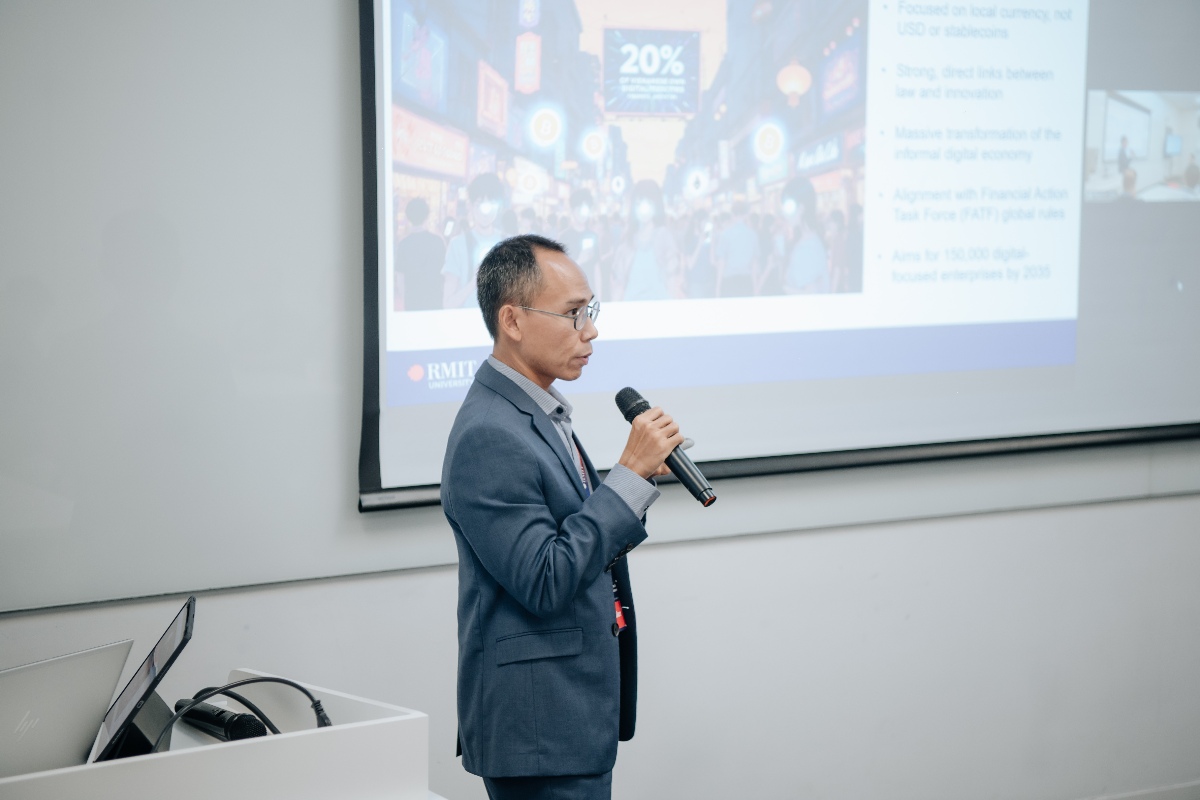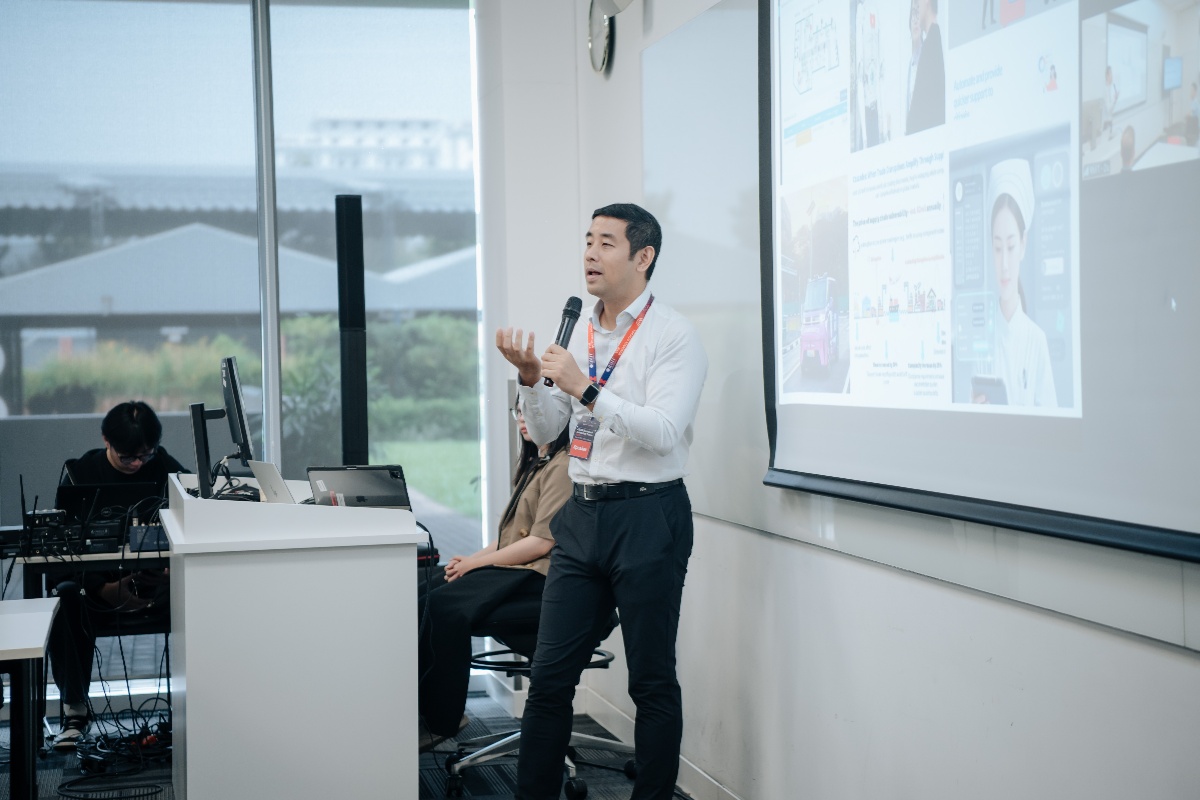
ASEAN is negotiating the Digital Economy Framework Agreement (DEFA), its first region-wide plan for shared rules on digital trade, payments, data and emerging technologies. Negotiation began in 2023 and is set to conclude by 2025, with signing possible in 2026.
But a framework on paper will not secure ASEAN’s future. Experts from RMIT University and regional partners across Southeast Asia agreed that progress depends on two pillars: AI and finance as growth catalysts, and policies and infrastructure as the foundation.
Artificial intelligence is reshaping productivity and global trade. “AI is going to be a transformative force and will play a significant role in ASEAN’s digital economy strategy,” said Professor Kok-Leong Ong, Director of the College of Business & Law’s Technology Initiative at RMIT University (Australia). “It won’t be a smooth ride. The journey will be bumpy, but the scale of opportunity is huge.”
 Dr Huy Doan, Senior Lecturer in Finance at RMIT Vietnam, shared insights on Vietnam’s pioneering legislation on digital assets. (Photo: RMIT)
Dr Huy Doan, Senior Lecturer in Finance at RMIT Vietnam, shared insights on Vietnam’s pioneering legislation on digital assets. (Photo: RMIT)
He noted ASEAN’s digitally native youth as an advantage but warned of regulation and infrastructure gaps. “If ASEAN is to take advantage of this transformation, we must get skills right. That means cultivating a strong ‘tech DNA’ and preparing future-ready graduates who can thrive in AI-enabled industries,” he said.
Vietnam offers an example. “This year, Vietnam became the first country in Southeast Asia to enact a law on the Digital Technology Industry and a resolution on piloting the crypto asset market (Resolution 05/2025/NQ-CP) – a comprehensive policy framework that sets out clear rules on ownership and safe usage,” said Dr Huy Doan, Senior Lecturer in Finance at RMIT Vietnam.
He explained that the resolution not only defines ownership and trading rights but also requires all transactions to be conducted in Vietnamese Dong, protecting monetary sovereignty while ensuring smoother implementation. Trading companies must also maintain a minimum capital level higher than that required for commercial banks, helping reduce fraud risks and strengthen investor confidence.
 Dr Kevin Nguyen, Program Manager for Online Programs and Courses at The Business School of RMIT Vietnam, outlined the university’s five-pillar AI adoption strategy and integration roadmap. (Photo: RMIT)
Dr Kevin Nguyen, Program Manager for Online Programs and Courses at The Business School of RMIT Vietnam, outlined the university’s five-pillar AI adoption strategy and integration roadmap. (Photo: RMIT)
“For years, digital asset trading largely took place on informal, unregulated exchanges with little legal protection,” Dr Huy said. “The new resolution brings this activity into the open under clear, transparent rules so people can invest and build with greater confidence. Alongside this, the government is backing the shift with tax incentives, subsidies, and policies that encourage startups and foreign investors - all supported under the new Digital Technology Industry Law.”
“With around 21 percent of Vietnamese adults already using or owning digital assets – the highest rate in ASEAN – and a target of 150,000 digital tech firms by 2035, Vietnam’s approach is bold, practical and future-ready – a blueprint that really sets the country apart in the region,” Dr Huy said.
Complementing this, Dr Kevin Nguyen, Program Manager for Online Programs and Courses at The Business School, RMIT Vietnam, shared RMIT’s experience in embedding AI into teaching and operations based on five pillars - a unified vision, ethical standards, industry collaboration, digital literacy, and iterative implementation. These pillars are supported by an AI Integration Roadmap that moves from foundational literacy and responsible use to discipline-specific applications, and finally to career readiness with tools for CVs, interviews and digital portfolios.
“Our strategy is not about quick fixes. We see AI adoption as a long-term investment in people and systems. If ASEAN follows this path, it can turn its demographic advantage into real digital competitiveness,” Dr Kevin said.
Technology alone is not enough. Associate Professor Zhou Yimin of the National University of Singapore pointed to the ASEAN Smart Cities Framework, which envisions competitive, sustainable and liveable cities. However, he cautioned, “the real question is whether ASEAN cities are ready to translate that vision into practice.”
 Associate Professor Zhou Yimin from the National University of Singapore discussed the ASEAN Smart Cities Framework and governance challenges. (Photo: RMIT)
Associate Professor Zhou Yimin from the National University of Singapore discussed the ASEAN Smart Cities Framework and governance challenges. (Photo: RMIT)
AI is already enhancing services from chatbots to healthcare apps, yet agencies often work in silos, with fragmented data and little incentive to integrate. “From smarter planning and resource efficiency to the risks of exclusion and data misuse, governance will be critical. The real measure of success will be whether AI benefits all urban communities, rather than a privileged few,” Associate Professor Yimin said.
According to Mr Tran Anh Tuan, Public Sector Lead for Vietnam at Amazon Web Services, although ASEAN’s digital economy was expected to reach about US$263 billion in 2024, growing 15 per cent year-on-year, it remains small compared with the global US$16 trillion. “Cloud platforms, secure systems and reliable connectivity are essential,” said Mr Tuan.
 Mr Tran Anh Tuan, Public Sector Lead for Vietnam at Amazon Web Services, highlighted the uneven state of ASEAN’s digital infrastructure. (Photo: RMIT)
Mr Tran Anh Tuan, Public Sector Lead for Vietnam at Amazon Web Services, highlighted the uneven state of ASEAN’s digital infrastructure. (Photo: RMIT)
While Singapore leads in data centres, countries like Myanmar, Cambodia and Laos lag far behind. Millions in ASEAN countries remain under-connected or usage gap. ASEAN governments are offering incentives from 5G subsidies to tax breaks for data centres. Regional collaboration, policy harmonization, and focus on digital literacy are key to achieving ASEAN’s vision of becoming a leading digital economy.
Agreeing with these insights, Associate Professor Binh Nguyen – Associate Head of Economics & Finance and Co-Lead of the Centre for Business and Emerging Technologies (CBET) at RMIT Vietnam – emphasised at the ASEAN Business & Technology Forum 2025 that ASEAN’s digital ambitions will require not only innovation but also coordination.
“It was striking to see how unevenly developed ASEAN’s digital infrastructure remains,” he said. “If the region is to grow its digital economy to US$1–2 trillion by 2030, we must not only build more infrastructure but also make better use of what we already have. This can only be achieved through deeper collaboration – and DEFA has the potential to accelerate that journey.”
Story: Quan Dinh H.
Vietnam’s ports face rising pressure to cut emissions. New research from RMIT reveals the risks, gaps, and cooperation needed for a credible, sustainable transition.
It is not “AI versus humans”, but AI empowering humans to deliver intelligent, personalised, and inclusive banking experiences.
Five finalist teams from Ho Chi Minh City, Hanoi and Gia Lai showcased tech-driven business ideas inspired by Vietnam’s cultural identity at the RMIT Business Plan Competition 2025 Grand Finale.
The dominance of foreign-invested companies in Vietnam’s high-tech sector limits technology spillovers and domestic productivity gains, according to researchers from The Business School at RMIT Vietnam.